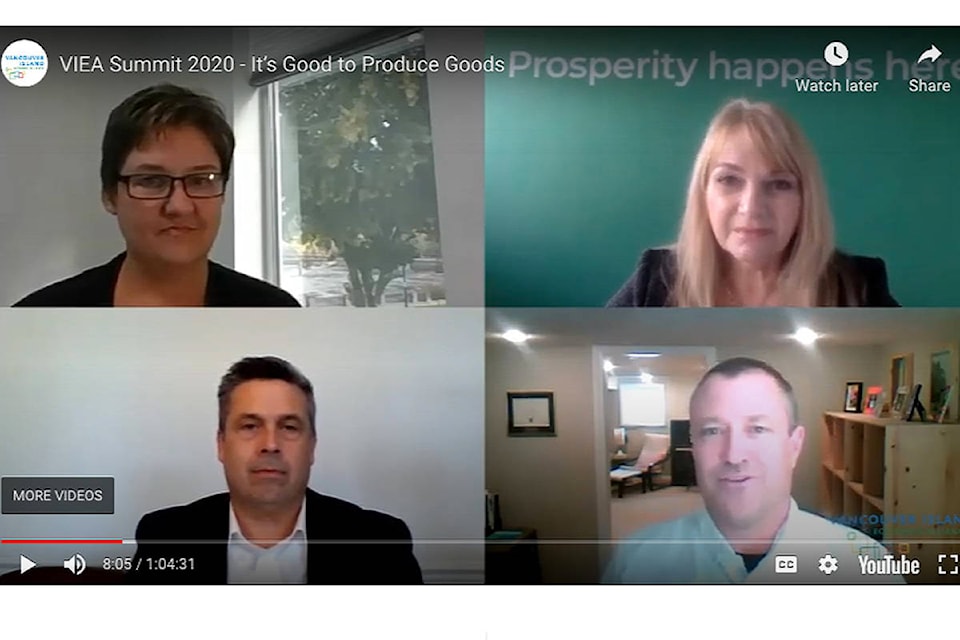Creating a circular economy revolves around a doughnut, or at least a doughnut-based model.
It’s Good to Produce Goods: New Thinking About Local Economic Resiliency, was a morning session at the State of the Island Economic Summit on this week as experts in community planning, economy and land development discussed how shifts in thinking can guide communities toward manufacturing-based, but environmentally sustainable local economies, known as circular economies.
The concept, conceived by economist Kate Raworth, is based on a doughnut and was explained by panelist Jacomien van Tonder, project coordinator with Metal Tech Alley, a B.C. firm that helps companies adopt circular economy practices.
“You have the inside and the outside of the doughnut. The inner circle is the social foundation and the outer circle is the ecological ceiling,” van Tonder said.
RELATED: Not-so-rosy State of the Island report caps off virtual summit
RELATED: Prime minister greets Vancouver Island economic summit attendees
“So we produce those goods that we need to live, but you need to take the outer circle, which is the ecological ceiling, into account … and you have to respect that if you want to the Earth to thrive and to survive. So for us, it’s a system where we have to survive, but you have to do it within the boundaries of what the Earth gives you.”
The drive to find circular economy-based ways to bring manufacturing of goods back to Canada has been accelerated by the COVID-19 pandemic, which disrupted global supply chains and created high demand and shortages in a wide spectrum of products and raw materials, ranging from surgical masks to germanium – used in the manufacture of thermometers – and copper, which has anti-fungal, anti-viral and anti-bacterial properties.
With global supply chains suddenly unreliable, local companies such as VMAC and Harmac stepped in to fill supply shortfalls. A cottage industry of home-made mask making also sprung up, effectively bringing home production of items normally made overseas.
Panellists discussed how localizing production was already happening around the world pre-COVID, especially in Europe where communities are finding new ways to invest in commercial-scale manufacturing while meeting local demands for environmental sustainability.
The trend is forcing new thinking about land use, resources, transportation infrastructure and other factors that affect decisions to invest in communities. There are also social challenges to encouraging circular economic growth through local manufacturing that include opposition from groups and individuals who are against drawing manufacturing to their regions.
“The one unspoken elephant in the room is the social licence and how various community voices can be quite challenging in major investment opportunities,” said Ross Blackwell, Urbanics Consulting executive vice-president. “As we all know, it’s a very risky thing bringing in new money to a community and investment looks for some degree of assurity and the less stable that social licence, is the less assurity, and it means investment may choose to look elsewhere. It’s one of the challenges that we try to unpack and try to find solutions to.”
Zoning regulations are another potential “pinch point” restricting investment, Blackwell said. There often needs to be flexibility to protect baseline conditions that ensure the health of the environment and community and avoid uncertainty caused by potential social discord and activism associated with re-zoning that can cause investors to choose other locations.
“Flex zoning” can allow latitude to accommodate unforeseen situations and allow communities to take advantage of opportunities.
The circular economy concept brings together thinking that has been around for a long time and combines sustainable development, product design and innovation under one umbrella, said Paul Shorthouse, senior director with the Delphi Group.
The concept is based on three key principles: rethinking resource consumption and designing waste and pollution out of products and services, optimizing products and components for highest value and keeping them in use for as long as possible by designing for durability, reusability and repairability; and preserving ecosystems by minimizing waste through incineration and other forms of disposal.
“It’s really about moving away from what we have today, which I call the linear model, which is take or extract – you make and then at the end of the product’s lifetime you dispose of or waste that product,” Shorthouse said.
“What the circular economy is looking to do, within the finite planet of resources we live on, is decouple those resources from economic activity and eliminate the concept of waste … through that sort of re-thinking it really creates major opportunities for new investment, for innovation, for jobs and businesses.”
For more news from Vancouver Island and beyond delivered daily into your inbox, please click here.
photos@nanaimobulletin.com
Like us on Facebook and follow us on Twitter
